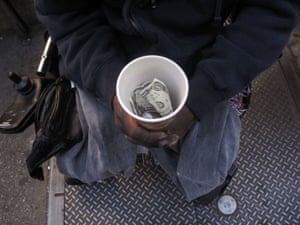I spent Saturday morning at the public library with my 2.5-year-old daughter. She sat in the centre of a multi-racial, multi-lingual group of toddlers, spread her arms out as wide as they would go, and screamed: “He turned into a beautiful butterfly!” at the end of the consummate classic, The Very Hungry Caterpillar. The parents and grandparents giggled at the collective exuberance of little ones. The kids’ insanely spongy brains soaked up the sea of words surrounding them.
This may sound like a mundane scene, but it’s a surprising triumph for philanthropic equity – one of the few that exists at a meaningful, functional scale in our increasingly unequal country. At a time when early childhood has exploded as a lucrative market opportunity, no money is exchanged at the nation’s public libraries.
Why? Because in the 1850s, a wealthy guy invited a poor, 13-year-old immigrant boy to spend Saturday afternoons at his private library in Pittsburgh.
That boy grew up to be steel magnate Andrew Carnegie. Carnegie rememberedthat, as a child, “I resolved, if wealth ever came to me, that it should be used to establish free libraries.” True to his word, Carnegie’s funding built about half of the 3,500 public libraries that existed by 1920.
Philanthropy has come a long way since the “Patron Saint of Libraries” took a childhood experience and turned it into a national legacy. Too often, it feels like we’ve lost our core wisdom about how change actually happens.
As they say, money can’t buy love. It can’t, ultimately, buy equity either. Both start with the seed of relationship.
There would be no three-year-old black kid in Oakland screaming hungry caterpillar exuberance without Andrew Carnegie. And there would no Andrew Carnegie without that Pittsburgh bibliophile.
So what does this mean for philanthropy? It means that the only philanthropy worth engaging in – both ethically and strategically speaking – is the kind that honours the wisdom of relationships and the power of money.
In what organiser and human rights activist Ella Baker deemed the “foundation complex” in 1963, those with money usually call the shots. Typically, a foundation positions itself as the expert and judges the merits of a nonprofit to solve a particular problem, whether it’s childhood hunger, or deforestation, or homelessness.

A girl stamping her own book at the old Aberystwyth Carnegie-funded public library, Wales. Photograph: Keith Morris/Alamy
I’ve been on the phone myself, scrambling to feel worthy of a foundation officer’s attention and money; nothing has inflicted me with a more toxic form of impostor syndrome. The questions foundation representatives ask, like those little bubbles on a standardised test, seem to pop up one after the other. With each one, I feel my breath get shallow. I’m feverishly tap-dancing when what I want to be doing is have good faith, meaningful conversation.
With individual donors, the hierarchy is often softened with social graces – a cup of coffee, a chat about shared passions, the scent of camaraderie – but ultimately the power dynamic is no different. One of us has the means and therefore is in the position of judging the other’s “good works”. In some ways, these interactions can be even more demoralising because they are deeply confusing; sometimes it can feel like you are performing friendship.
In the midst of particularly demoralising experiences with wealthy philanthropists, I have often reminded myself of my own privilege – a white woman from an upper-middle-class background with an Ivy League degree. If these interactions make me feel this way, imagine how confusing and alienating they likely are for people even further afield of the social class of most philanthropists.
A note about philanthropists’ demographics: three-fourths of foundations’ full-time staff are white and nearly 90% are over 30. Women flourish at smaller foundations – about three of four fundraisers are female – but at those with assets of more than $750m, women comprise only 28.9% of CEOs and CGOs (chief growth officers).
Board leadership is even more demographically starved. “Fully 85% of foundation board members are white, while just 7% are African American and only 4% are Hispanic,” said Gara LaMarche, president of the Democracy Alliance. “Nearly three-quarters of foundations have no written policy on board diversity, and fewer than 10% of board members are under 40.”
This means a lot of people who are not white, male and older are hustling their asses off to understand the sensibility of those who are. They are spending energy being tactical about how they talk about their work and build relationships, however transactional or tokenising. I admire their commitment and acuity, but even if some get good at translating and tap-dancing for dollars, that should not comfort the philanthropic world about its own inclusivity or transparency.
It only means that some people are willing to put in the work to get good at the game, not that the game isn’t profoundly rigged or that it doesn’t distract from getting real work done.
And the truth is, I imagine it’s a disconcerting experience for most philanthropists, too. On some level, they must know that they’re not the wisest authorities on the issues they’re seeking to effect. Money doesn’t make you an expert on poverty alleviation; in fact, it can make you dumber with distance. And yet, traditional philanthropy is set up to put you – the one with financial wealth – in the position of playing god with something you deeply care about. Even if it strokes your ego to be the decider, it’s got to erode your sense of integrity.
How can we reinvent philanthropy with an eye toward true equity? How can we create new cultures and structures that allow resources – financial, experiential, energetic – to flow in ways that feel dignifying? How do we create paradigm-shifting shit together, not just send LinkedIn requests and push money and paper around?
One obvious thing we can do is work to change the demographics of those giving away money and sitting on boards. But even that isn’t a fix; it’s a good bet to slowly shift culture, but not a promise of radical restructuring. There has been a slight uptick in black executives at foundations, for example, but as soon as they arrive, many are looking for an out, according to the Association of Black Foundation Executives. They overwhelmingly cite as their reason for fleeing that they want to be “more directly engaged in creating community change.” Duh.
If we really want to reinvent philanthropy then we are going to have to look at the underlying historic and structural causes of poverty and work to dismantle them and put new systems in their place. It’s also about culture – intentionally creating boundary-bashing friendships, learning to ask better, more generous questions, taking up less space.
It’s about what we are willing to acknowledge about the origins of our own wealth and privilege. It’s about reclaiming values that privilege often robs us of: first and foremost, humility. But also trust in the ingenuity and goodness of other people, particularly those without financial wealth. And a more accurate sense of proportion – where and how are philanthropists really most crucial in the fight for a more just society?
Several groups are working to show us what this kind of giving might look like. An example: a group of trust fund kids, calling themselves the Gulf South Allied Funders, took their own inheritances, raised even more money from their own networks and then donated the sum to the Twenty-First Century Foundation, which has a long-standing presence in New Orleans. In the wake of Hurricane Katrina, they acknowledged their unfamiliarity with the community, and decided to funnel their resources to someone who could make a bigger difference.

Emergency response team volunteers clean up debris from a home destroyed by Hurricane Katrina. Photograph: Mark Humphrey/AP
Another: poor families in Boston and Detroit and Fresno track data about their own strengths and goals and then come together on a regular basis to talk about what they’re learning and the kinds of support they need. The families provide the moral support, while Family Independence Initiative provides the financial support in the form of scholarships, small business grants and other capital, on an as-needed basis.
And another: Self-Help, a family of nonprofit credit unions in North Carolina, California, and Florida, counter predatory lenders and high-fee check cashers in underserved communities by providing low-interest banking and loan services, financing community development projects and rehabilitating historic buildings with local partners. They celebrate the ways in which their current banking structure is significantly imprinted with the historic intelligence of African-American credit unions so critical during the Jim Crow era.
What makes these different than the average “foundation complex” experience? They have authentic, trusting relationships at the centre. They acknowledge history and local context. They walk their talk – moving beyond radical theory to radical practice.
To their credit, many of the world’s most powerful donors have begun to question the ethical underpinnings and best practicesof status quo philanthropy. In 2013,Peter Buffett, chairman of the NoVo Foundation, wrote a manifesto that, at its essence, was a call for more structural consciousness and less cognitive dissonance among wealthy altruists: “Because of who my father is, I’ve been able to occupy some seats I never expected to sit in. Inside any important philanthropy meeting, you witness heads of state meeting with investment managers and corporate leaders. All are searching for answers with their right hand to problems that others in the room have created with their left.”
More recently, Darren Walker, the President of the Ford Foundation, has called fora “new ‘gospel of wealth’ for the 21st century” – one that addresses “the underlying causes that perpetuate human suffering. In other words, philanthropy can no longer grapple simply with what is happening in the world, but also withhow and why.”
The shift in zeitgeist is promising. A critical mass of people working within philanthropy is hungry to do work with more ethical rigor; more systemic, cultural, and emotional intelligence; less bureaucracy and hubris. There is a growing conversation about these shifts. On paper, the will is there.
But philanthropists need more than “big ideas” about how their profession could and should change. They need radically new habits or these ideas just become bold in theory.
As Vu Le, the Executive Director of Rainier Valley Corps, points out: “True Equity takes time, energy, and thoughtfulness. It requires us to reexamine everything we know and change systems and practices that we have been using for hundreds of years. This is often painful and uncomfortable.”
In part, this is about scale. Philanthropists must push themselves to give more, and in particular, give more to address American poverty. Only 12% of total giving in 2015 went to “human services,” according to Giving USA. Wealthy donors are more likely to support the arts and higher education and less likely to give to social service charities, according to the Chronicle of Philanthropy. And they’re not as generous as those with less income: “The wealthiest Americans – those who earned $200,000 or more – reduced the share of income they gave to charity by 4.6% from 2006 to 2012. Meanwhile, Americans who earned less than $100,000 chipped in 4.5% more of their income during the same time period.”

In 2014, the poverty rate in the US reached 15%. Photograph: Spencer Platt/Getty Images
How and where do you meet potential grantees?
If you don’t have genuine relationships with those outside of your racial or class category, you’re going to have a hell of a time finding out about the most interesting, powerful work going on to tackle poverty.
How do you approach general operating funds or capital campaigns?
Have you ever noticed that foundations feel justified in spending millions on beautifully designed headquarters, but frown on nonprofits using money to spend a fraction of that on dignifying spaces of their own? Poor people, and those that partner with them, deserve fair salaries and beauty, too.
How can grant reporting be redesigned so it doesn’t create such huge frustration and a misuse of time and energy on the part of grantee organisations?
Human-centered design is so often heralded by foundations these days, but too often their own bureaucracies are filled with soul-deadening detail that is anything but humanising.
Do you build relationships for the long, systemic haul?
Funding also shapes and dictates our work by forcing us to conceptualise our communities as victimsAdjoa Florência Jones de Almeida, The Revolution Will Not Be Funded
Gara LaMarche takes his peers to task for talking big game about sustainability, but then essentially treating grantees like “the right wing would treat single mothers on welfare, imposing strict time limits and cutoffs – the fact is that most sustainability strategies are aimed at helping grantees move from dependency on one foundation to another.”
This may all seem “in the weeds”, but it has a huge impact of the daily lives of those tackling poverty on the ground. How we treat one another every day, as cliched as it may sound, becomes the nature of our relationships, and the nature of our relationships, becomes the nature of our institutions and, ultimately, systems.
Perhaps the most profound question that philanthropists can ask themselves at this ripe time for reinvention is this: what stories do you want or expect grantees to tell you? What stories do you tell about yourself?
Adjoa Florência Jones de Almeida of the Sista II Sista Collective in Brooklyn, NY,wrote in the groundbreaking anthology, The Revolution will not be Funded:
In theory, foundation funding provides us with the ability to do the work – it is supposed to facilitate what we do. But funding also shapes and dictates our work by forcing us to conceptualise our communities as victims. We are forced to talk about our members as being “disadvantaged” and “at risk”, and to highlight what we are doing to prevent them from getting pregnant or taking drugs – even when this is not, in essence, how we see them or the priority for our work.
Six years later, organiser and activist Mia Birdsong, took the TED stage and furthered the paradigm-shifting narrative: “The quarter-truths and limited plot lines have us convinced that poor people are a problem that needs fixing. What if we recognised that what’s working is the people and what’s broken is our approach?”

The story we’ve told about the poor in America, the story that we continue to ask them to tell in order to get funding, is that they’re broken. In fact, we are.
The ultimate irony of the way the philanthropic sector is structured is that it is actually the recipients – people of colour, the working class, women – that may be the most masterful at creating and maintaining long-lasting, catalytic relationships. They are disproportionately poor in terms of dollars and cents, but rich with experience of making a way out of no way and persevering in the face of huge, intractable, sometimes downright exploitative systems. This usually involves relying on friends and extended family, nurturing people’s gifts for the betterment of whole communities and having grace through challenge.
We have an ethical imperative to acknowledge and build new systems around that intelligence. Carnegie’s one ask of the public libraries that he funded, to be built in communities across the country, was that they each be engraved with an image of a rising sun and the words: “Let there be light.”
That light, for him, was present in books, but in truth, it was sparked by an unlikely relationship. Long-lasting change so often is.
No comments:
Post a Comment